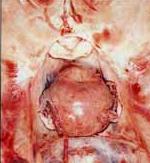Cushings Disease in Horses Pictures Difinition
Source(Google.com)
Introduction
Equine Cushing’s disease is one of the most common diseases of horses greater than 15 years of age. The clinical signs are associated with abnormally elevated hormone concentrations in the blood and along with other hormones, cortisol, plays an important role in this disease. This syndrome is better defined as Equine Pituitary Pars Intermedia Dysfunction (PPID) because it reflects the location within the brain that is abnormal. In humans, Cushing’s disease affects a different location within the pituitary gland, thus the reason why veterinarians prefer to call this disease PPID.
The pituitary gland is located at the base of the brain. In horses with PPID, the middle lobe of the pituitary gland (pars intermedia) becomes enlarged over time and results in over production of hormones. The growth of the middle lobe of the pituitary gland can compress the adjacent structures in the pituitary and hypothalamus resulting in loss of their function. The enlargement of the pituitary gland is often referred to as a pituitary adenoma.
Clinical Signs
Clinical signs of PPID can vary depending upon the stage of disease. The average age of horses diagnosed with PPID is 20 years, with over 85 percent of the horses being greater than 15 years of age. Although most common in aged horses, PPID has been diagnosed in horses as young as seven years of age. All breeds of horses can develop PPID, however ponies and Morgan horses have a higher incidence of the disease. The most classic symptom of PPID is a long curly hair coat that does not shed properly. This condition is referred to as hirsuitism.
Other symptoms that have been associated with PPID include excessive drinking and urination (polyuria/polydipsia), laminitis, lethargy, excessive sweating, muscle mass loss, repeated infections such as sole abscesses, tooth root infections, and sinusitis; infertility and bulging eyes that are a result of redistribution of supraorbital fat.
Horses with PPID may also be insulin resistant. What is insulin resistance? Insulin is a hormone produced from the pancreas in response to elevated blood glucose that occurs after a meal. In the normal horse, insulin stimulates the uptake of glucose by tissues. Insulin resistance is the failure of tissues to respond appropriately to insulin. The pancreas will continue to secrete insulin to compensate for decrease in tissue effectiveness; thus the resting serum insulin levels will be high in horses with moderate to severe insulin resistance. Insulin resistance can be confirmed by measuring insulin in the blood. Insulin resistance can contribute to muscle loss, abnormal fat accumulation, laminitis, excessive water consumption, frequent urination and increased susceptibility to disease.
Diagnosis
The best indication of PPID is the clinical sign of hirsuitism in the aged horse. The sensitivity of this clinical sign is better at predicting an abnormal pituitary than any diagnostic test available.
Horses that have subtle signs of PPID need to be tested to confirm the disease. Of the tests available, no single test is 100 percent accurate. The most commonly used tests in the field are the dexamethasone suppression test and the measurement of resting plasma ACTH concentration.
The dexamethasone suppression testis generally considered to be the most reliable diagnostic test for PPID. This test involves suppression of cortisol in a normal horse after administration of dexamethasone. A blood sample is collected for cortisol measurement around 4pm in the afternoon, dexamethasone is administered and 19 hours post-injection a second blood sample is collected for cortisol measurement. In horses with PPID, dexamethasone will not reduce serum cortisol production.
Cushing Disease in Horses Pictures Images Wallpapers Photos 2013

Cushing Disease in Horses Pictures Images Wallpapers Photos 2013

Cushing Disease in Horses Pictures Images Wallpapers Photos 2013

Cushing Disease in Horses Pictures Images Wallpapers Photos 2013

Cushing Disease in Horses Pictures Images Wallpapers Photos 2013

Cushing Disease in Horses Pictures Images Wallpapers Photos 2013

Cushing Disease in Horses Pictures Images Wallpapers Photos 2013

Cushing Disease in Horses Pictures Images Wallpapers Photos 2013

Cushing Disease in Horses Pictures Images Wallpapers Photos 2013

Cushing Disease in Horses Pictures Images Wallpapers Photos 2013

Cushing Disease in Horses Pictures Images Wallpapers Photos 2013